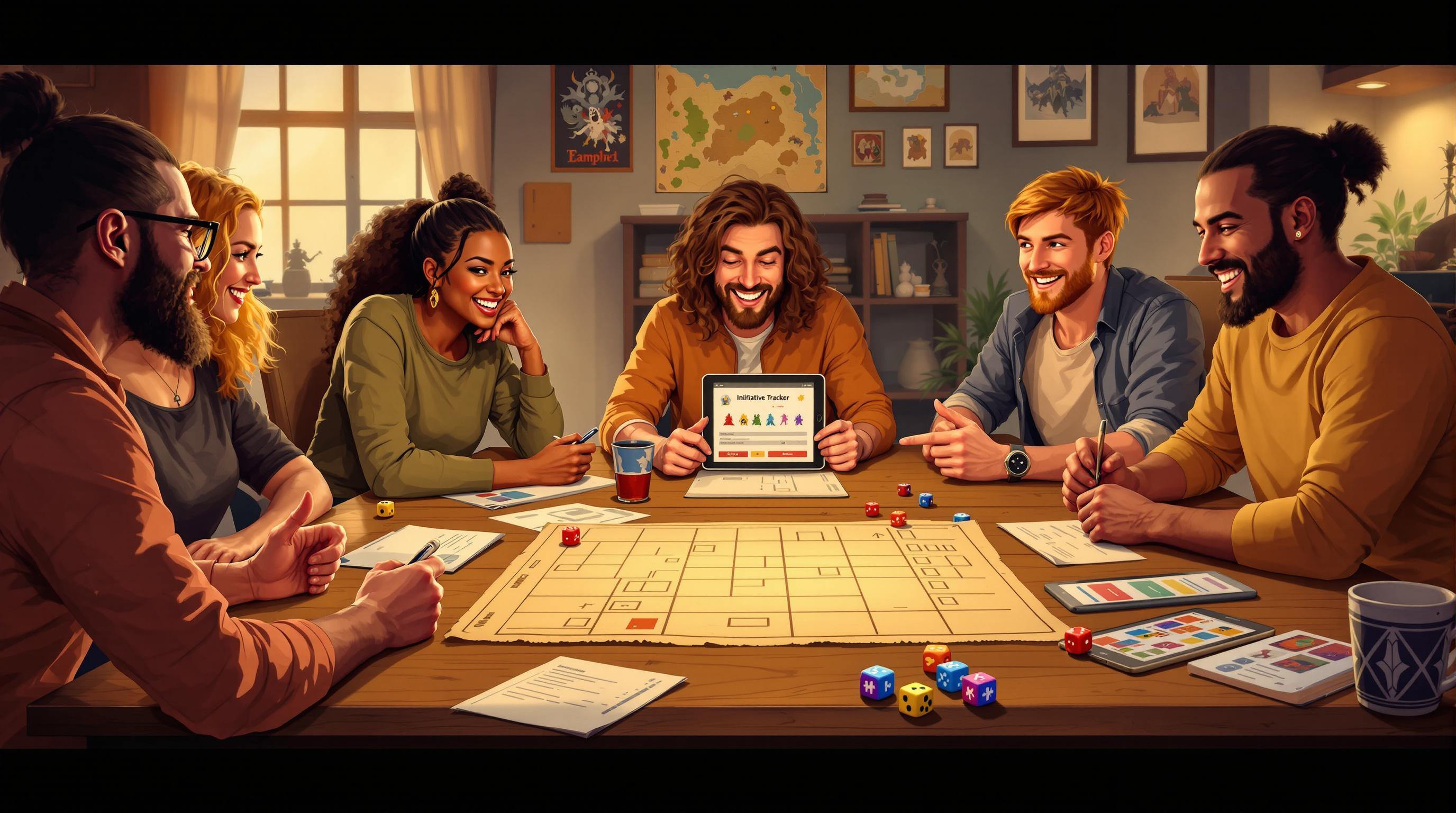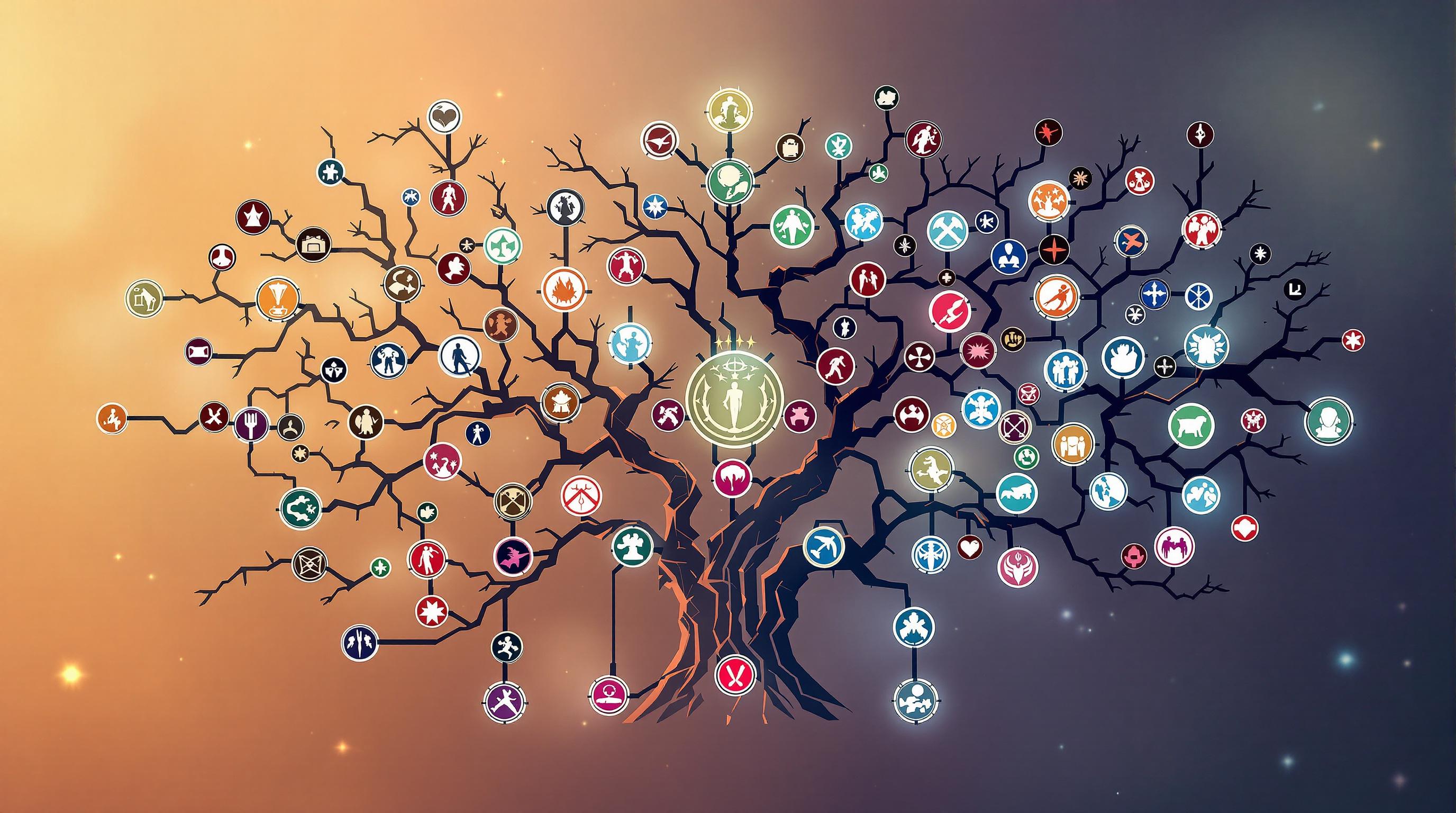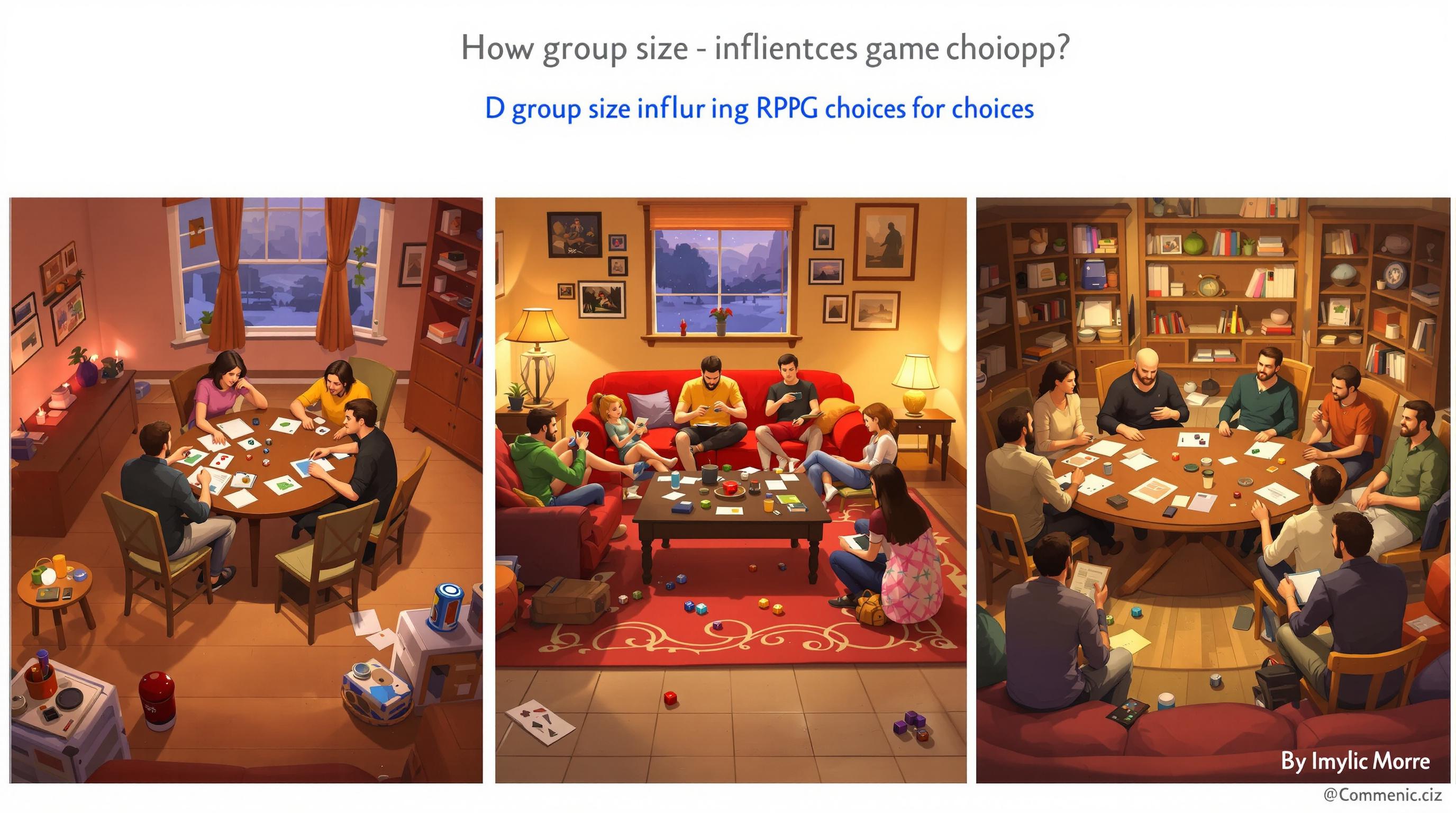Want to kick off your tabletop roleplaying game (TTRPG) campaign right? You need a Session Zero. Here's what you need to know:
- What it is: A pre-game meeting to align expectations and set up your campaign
- Why it matters: Prevents misunderstandings and creates a better gaming experience
- Key components:
- Discuss campaign setting and style
- Create characters and establish party dynamics
- Set table rules and use safety tools
Quick Checklist:
- [ ] Choose game system and campaign theme
- [ ] Set character creation guidelines
- [ ] Establish table expectations and boundaries
- [ ] Plan game schedule
- [ ] Select communication tools (e.g., Discord)
- [ ] Prepare safety tools (e.g., X-card)
- [ ] Set up gaming platform (VTT for online, materials for in-person)
Session Zero typically takes 2-3 hours. It's worth the time to ensure everyone's on the same page and excited to play.
Related video from YouTube
What Session Zero Needs to Do
Session Zero is the foundation of any great TTRPG campaign. It's where everyone gets on the same page about the upcoming adventure.
Main Goals
Session Zero is all about setting up your campaign for success. You need to tackle three big things:
1. Campaign Framework
What's your game world like? Is it dark and gritty or light and fun? Nail down these details.
2. Character Creation Guidelines
How do you want players to build their characters? Make sure they'll work well together.
3. Table Expectations
Set clear rules and boundaries. This keeps everyone comfortable and having fun.
"Session Zero is your chance to build a strong foundation for your campaign. By clearly communicating game rules, themes, boundaries, and attendance expectations, you set the stage for a successful and enjoyable experience for everyone involved." - Dice Dragons
Player and DM Expectations
You've got to get everyone on the same page. If you don't, your campaign could crash and burn.
"If someone arrives expecting high fantasy and political intrigue but you're running a sillier monster of the week-style adventure, players will end up disappointed." - Maddie, Dicebreaker
Here's what you need to talk about:
| Aspect | What to Discuss |
|---|---|
| Game Style | Lots of fighting or lots of talking? |
| Character Death | What happens when someone dies? |
| Player Involvement | How much of each character's backstory will you use? |
| Campaign Tone | Serious business or just for laughs? |
Don't forget to talk about touchy subjects. Use tools like Lines and Veils to set boundaries everyone's okay with.
"Death should usually advance the story is my feeling, and bring emotional weight and depth - but folks have to be part of it." - Experienced DM, D&D Beyond Forums
Setting Up Characters and Campaign Rules
Character Rules
Let's talk about creating characters together. It's a great way to build a solid party from the get-go. But before you dive in, you need to set some ground rules.
James Haeck, Lead Writer for D&D Beyond, puts it this way:
"Character creation is the fun part of session 0. Collaboratively creating your characters and their backstories can provide tons of benefits for a fledgling campaign."
So, what do you need to nail down? Here's the rundown:
- Allowed Content: What races, classes, spells, and feats are on the table?
- Starting Level: Where are your characters power-wise, and how will they grow?
- Stats Generation: How will you determine those all-important ability scores?
- Background Rules: What kind of origins and histories are cool for your world?
- Group Bonds: How are your characters connected?
Speaking of bonds, have each player come up with three for their character. These could be family ties, rivals, mentors, or organizations. It's a great way to root characters in your world and spark some juicy storytelling opportunities.
Campaign Type and Mood
Now, let's talk about the vibe of your campaign. The tone you choose will shape everything from character creation to how you play the game. D&D 5e is pretty flexible - you can go in a lot of different directions.
Here are some popular campaign tones to consider:
- Adventure: Think Pirates of the Caribbean. It's all about thrilling quests with a dash of humor.
- Legends: Channel your inner Greek mythology. Epic tales of gods and heroes.
- Darkness: Lord of the Rings style. The world's in trouble, and evil's on the rise.
- Intrigue: Game of Thrones, anyone? Political scheming and backstabbing galore.
- Exploration: Studio Ghibli films are a great inspiration here. It's all about discovery and the wonder of the wilderness.
One D&D reviewer on EN World had this to say:
"The tone 5e does best is a kind of Pirates of the Caribbean / Guardians of the Galaxy 'wacky friends going on adventures' vibe."
But don't feel locked into one tone for the whole campaign. You can mix it up as you go. Maybe start with a village festival (celebration), then throw in a sudden invasion (panic). From there, your party could embark on a quest for justice (determination), and finally, end with a victory celebration (triumph).
Planning and Basic Rules
Game Schedule and Missing Sessions
A consistent game schedule is key for TTRPGs. Most groups meet weekly or every two weeks, with sessions lasting 2-4 hours. Talk about everyone's availability during session zero.
Paul Camp, a TTRPG author, says:
"Set a good example by never getting angry with your players or punishing them for not showing up for a gaming session. Taking away XP or excluding them from the party isn't going to make them want to attend the next session."
What about players who can't make it? You need a plan. Here are two common ways to handle it:
1. Character "on business"
The character isn't there. They don't get XP or rewards. This works for players who want full control of their character.
2. Another player runs the character
The character stays with the group. They get XP and rewards, but they might face risks too. This keeps the story moving.
Staying in Touch
Talking between games keeps things running smoothly. Many groups use Discord. It's great for organizing your campaign.
A good Discord server should have:
- A main channel for schedules and announcements
- Channels for each storyline
- Private spots for character notes
- A place just for rolling dice
- Voice channels for main games and side chats
One player shares their setup:
"In my server, each game gets its own private channel and there's a channel to discuss character builds."
sbb-itb-b8b00a5
Player Safety and Comfort
Safety tools are key for a fun game where everyone feels at ease. They help set limits and deal with touchy subjects during your campaign.
Safety Tools and Warnings
The X-card system is simple but works well. Put an index card with a big X on the table. Players can tap it if they're not okay with something, and the GM can change the scene. No need to explain why.
Nathan Carmen from Tricky Troll Games says:
"Utilizing the X-Card at your table lets the players know immediately that you care about their feelings."
Content warnings matter too. Don't list every possible trigger. Just focus on 2-3 main themes that'll show up a lot in your campaign. This helps players get ready or skip stuff they might not like.
Here are some other tools for talking about limits:
| Tool | What it does | How to use it |
|---|---|---|
| Lines | Sets hard limits - topics that are off-limits | Players list what they won't tolerate |
| Veils | Sets soft limits - topics okay to mention but not detail | Players say what can be hinted at but not described |
| Consent Flower | Non-verbal way to communicate during play | Use colored cards: green (go), yellow (careful), red (stop) |
Setting Boundaries
Take a few minutes during Session Zero to talk about boundaries. Adam, a seasoned Dungeon Master, says:
"By having these conversations as early, early, early in the process of getting a new campaign off the ground, all your players will know that you're taking their safety at your table seriously and you'll start building that all-important trust from the jump."
People often set boundaries around things like violence, relationships, or personal trauma. Use the RPG Consent checklist to go through possible content with your group. This sets clear expectations and helps avoid awkward moments during the game.
Game Setup and Tools
Setting up your game space and tools is key for a smooth Session Zero. Here's how to get ready, whether you're playing online or in-person.
Platforms and Materials
For online play, you'll need a Virtual Tabletop (VTT). Roll20 is popular and beginner-friendly. It's free to start, with paid options if you want more features.
If you're after more control, check out Foundry VTT. It's pricier upfront but offers more customization.
Robin Langfield Newnham, Founder of Golem Factory, points out:
"Most of these online groups started very LoFi, by simply using video conference software like Skype, Zoom, Google Meet or Microsoft Teams."
Here's a quick look at some VTT options:
| Platform | Cost | Best For |
|---|---|---|
| Roll20 | Free - $99.99/year | Beginners, basic features |
| Foundry VTT | $50 one-time | Advanced customization |
| Fantasy Grounds | $39 - $149 one-time | Official content libraries |
| Owlbear Rodeo | Free | Simple map sharing |
Playing in person? Don't forget:
- Dice (a full set)
- Writing tools and paper
- Rulebooks
- Character sheets
- A speaker for background music
Digital Tools and Rules
Most VTTs don't have voice chat, so you'll need Discord or Zoom too. Dicebreaker notes:
"Most VTTs for D&D and other RPGs are not one-stop shops when it comes to the needs of the gaming group."
For maps, try Dungeon Fog. And for character sheets, D&D Beyond works well with some VTTs.
Keep it simple but effective. Fantasy Grounds has great rules integration but takes time to learn. If you want something basic, Shmeppy offers digital whiteboarding for $4.99/month (GMs only, players join free).
Session Zero Checklist
A good Session Zero lays the groundwork for a great TTRPG campaign. Here's how to nail it:
Before the Session
Tell players what to bring and what to expect. Get your space ready, whether it's online or in-person. Have character sheets and rulebooks handy.
Level 1 Geek, who wrote the Ultimate D&D Session 0 Checklist, puts it simply:
"The goal of a session 0 is to get everyone in your group on the same page."
Your prep checklist:
| Online Game | In-Person Game |
|---|---|
| Set up VTT, share Discord/Zoom links | Arrange table, chairs, lighting |
| Prep digital sheets, PDFs | Get physical sheets, extra dice |
| Collect Discord names, time zones | Get contact info, give directions |
| Set up digital X-card system | Prepare physical X-cards, handouts |
During the Session
Kick things off with introductions. Ask about TTRPG experience. Maddie from Dicebreaker nails why this matters:
"Making sure everyone is happy at the table is really important, so taking a minute to cover means you'll hopefully avoid upsetting anyone."
Talk about:
- What kind of campaign you're running
- How to make characters
- Table dos and don'ts
- Using safety tools
- When you'll play
- How you'll keep in touch
After the Session
Sum up what you talked about. Share the key points on Discord, email, or wherever your group chats. Make sure everyone:
- Finished their character sheet
- Can access the tools and platforms
- Knows when you're playing next
- Has the group's contact info
- Gets the table rules and boundaries
Wrap-Up
Session Zero lays the groundwork for a great TTRPG campaign. It gets everyone on the same page and builds a shared vision. Here's what James Haeck, Lead Writer for D&D Beyond, says about it:
"D&D is meant to be fun for everyone involved. Making sure everyone is comfortable and their expectations for the game are being met is the first step to ensure a long, successful adventure for everyone!"
A good Session Zero stops problems before they start. Take this Vampire: The Masquerade game, where a player quit mid-game because expectations didn't match up. A solid Session Zero could've prevented that.
Your Session Zero might take 15 minutes or 3 hours - it depends on your group. The key? Keep talking. Here are some tried-and-true focus areas:
| Focus Area | Benefits |
|---|---|
| Campaign Primer | Clear vision and themes |
| Character Bonds | Better party dynamics |
| Safety Tools | Comfortable gaming |
| House Rules | Fewer conflicts later |
Session Zero isn't just about rules. It's about getting pumped for your adventure. Minva Tabletop Design Co. puts it this way:
"A Session Zero is an important part of any game that should not be skipped over or forgotten about."
For long campaigns, talk about schedules, how much time everyone can commit, and how you'll keep in touch. It's worth the time upfront. Make a campaign primer with themes, settings, and key NPCs to help players see their place in the story.
Above all, make it a team effort. When players feel heard and help shape the campaign, they're more likely to stick around. Your Session Zero is like a living document - you can come back to it throughout the campaign to make sure everyone's still on the same page.
FAQs
How long should a session zero be?
Session zero length can vary a lot. Cat Webling explains it as "the first time you meet up with your players about a new campaign before it starts, before the official 'session one.'" Some groups finish in 15 minutes, others need hours.
GM Tim says Session Zero needs enough time to "set expectations, build characters, and create a safe space for your TTRPG." Most groups find 2-3 hours works well. This gives time to create characters, set campaign expectations, and discuss safety tools.
How long should a D&D session 0 be?
For D&D, James Haeck, former Lead Writer for D&D Beyond, says:
"How long should a session last? About 3 hours is normal, but if you only meet once a month (and if your group is up for it), consider going for those 6+ hour marathons!"
Several factors affect the length:
| Factor | Impact on Time |
|---|---|
| Group Size | +30 mins per extra player |
| Character Creation | 1-2 hours if done in session |
| Campaign Complexity | +1 hour for detailed settings |
| Meeting Frequency | 6+ hours for monthly groups |
It's better to take your time than rush. Dice Dragons notes, "The duration of a session 0 can vary, but it typically takes several hours" to set up a solid campaign foundation.


